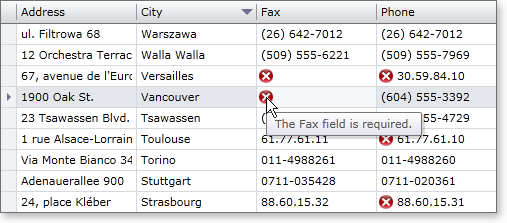Attributes-Based Validation
The GridControl supports DataAnnotations attributes that specify data validation rules. You should reference the System.ComponentModel.DataAnnotations assembly to use data annotation attributes.
Data Annotation Attributes
| Validation Attribute | Description |
|---|---|
| CustomValidationAttribute | Specifies a custom validation method. |
| DataTypeAttribute | Specifies a particular data type, such as an e-mail address or a phone number. |
| EnumDataTypeAttribute | Ensures that the value exists in an enumeration. |
| RangeAttribute | Designates minimum and maximum constraints. |
| RegularExpressionAttribute | Uses a regular expression to determine valid values. |
| RequiredAttribute | Specifies that a value must be provided. |
| StringLengthAttribute | Designates maximum and minimum number of characters. |
Default Behavior
The GridControl displays error icons (![]() ) within cells with invalid values, and provides error descriptions displayed as tooltips. In this case, you cannot focus another cell until the cell’s value is corrected:
) within cells with invalid values, and provides error descriptions displayed as tooltips. In this case, you cannot focus another cell until the cell’s value is corrected:

Demo: Data Validation
Custom Validation
The following validation options allow you to override default behavior:
Validation Attribute | Description |
|---|---|
If set to false, hides validation errors specified via DataAnnotations attributes. | |
If set to true, posts the invalid value to a data source and allows the cell focus to be moved to another cell. |
Note
The attributes-based validation does not work when using the ColumnBase.Binding property.
Refer to the How to: Implement Attributes-Based Validation example to learn more.